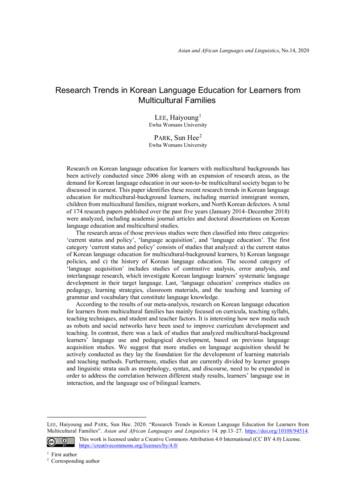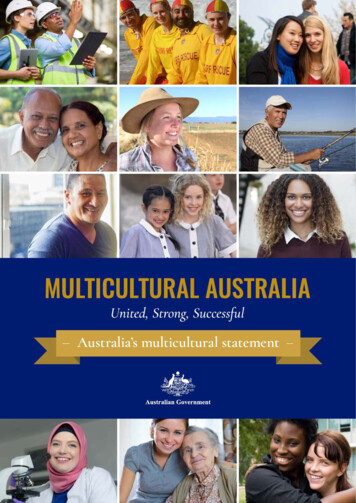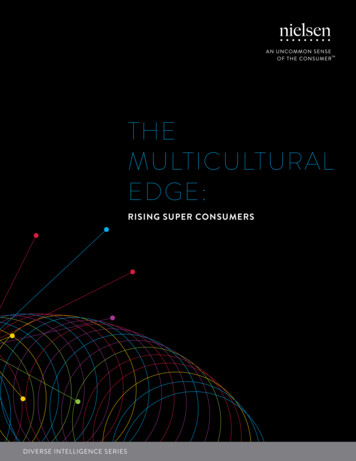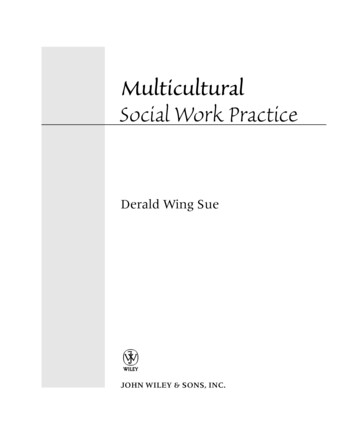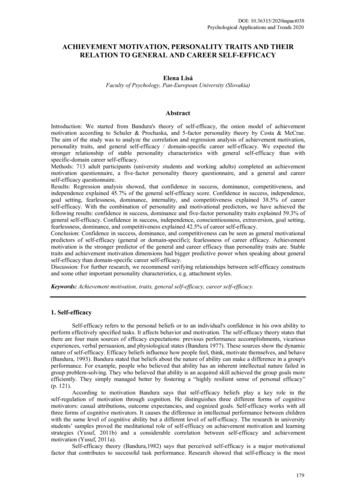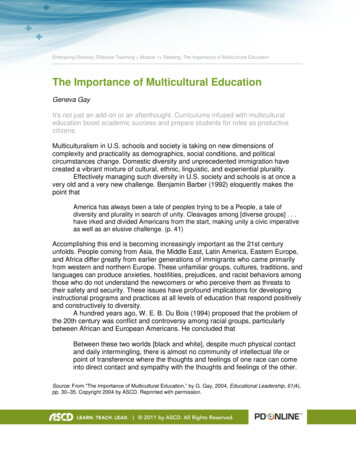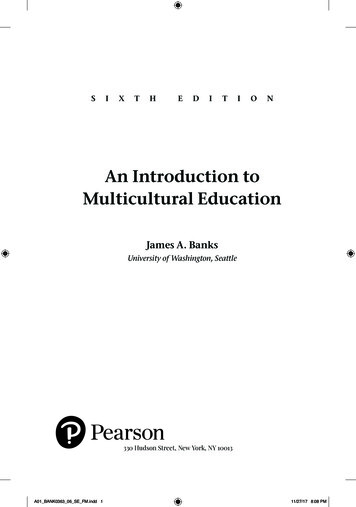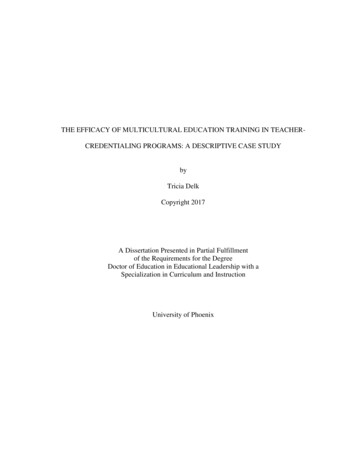
Transcription
THE EFFICACY OF MULTICULTURAL EDUCATION TRAINING IN TEACHERCREDENTIALING PROGRAMS: A DESCRIPTIVE CASE STUDYbyTricia DelkCopyright 2017A Dissertation Presented in Partial Fulfillmentof the Requirements for the DegreeDoctor of Education in Educational Leadership with aSpecialization in Curriculum and InstructionUniversity of Phoenix
ABSTRACTThe purpose of the qualitative descriptive embedded single case study research was toexplore how multicultural curriculum and instruction in a teacher-credentialing programprepared pre-service teachers to work with diverse students. The problem was theinadequacy on the part of teacher-credentialing programs to train pre-service teachers tomake cultural contact with their students may impede the pedagogy students receive.Data were generated from in-depth interviews with 19 pre-service teachers andcurriculum analysis. A lack of cultural competence preparation within teachercredentialing programs emerged through interviews with students. Analysis of thecurriculum content showed that courses pre-service teachers must take are not providingenough opportunities for them to learn how to become culturally competent. Almost allparticipants stated that their perception of preparedness to meet the cultural needs ofdiverse students at the conclusion of their program was deficient. Four themes emerged:(1) The teacher-credentialing program should focus on bridging the gap between teachersand diverse students, (2) The teacher-credentialing program should focus on theimportance of cultural integration, (3) The teacher-credentialing should revamp thecomponents of their courses to include multicultural curriculum, and (4) The teachercredentialing program should focus on developing an awareness of each student’sdifferences. Recommendations may provide an opportunity to improve teachercredentialing programs to include multicultural education into every course to train preservice teachers to become culturally competent and ready to create a culturallyresponsive classroom.iii
DEDICATIONI dedicate this dissertation first to almighty God who has provided me with morefavor and faith in myself than I could have ever imagined. I also dedicate thisdissertation to my dad Larry Delk, who passed too soon to see me reach this goal ofearning my doctorate. I know that he has been right by my side every minute of thisjourney pushing me to succeed and fulfill my dreams. I also cannot thank my momDebbie for putting up with me for the past four years of illnesses, tears, frustration andjust sheer exhaustion. Not once did she ever doubt that I could achieve my goal ofgetting my doctorate. She has always been my biggest cheerleader and without her faithin me, I could have never completed my dissertation.Throughout this journey, my family has been the foundation of my strength andtheir ongoing encouragement led me to my commitment to fulfill my goals. Mydedication also goes to my brother Bryan, my sister Marsha, my sister-in-law Lanette, mybrother-in-law Joey, and my wonderful nieces and nephew who are the light of my life:Ashley, Eric, Nathan, Kylie and Gabriella. I would also like to dedicate this dissertationto my friends that are like sisters to me: Rhiannon, Robin, Christi, Jennifer, Brianna,Summer, Edwina (Eddie), Christina and my best friend Victoria, who I “convinced” tocome along with me for this crazy but amazing journey. Victoria and I have pushed eachother to succeed and she was always the shoulder I could cry on when I just was not surewe were going to make it. Thank you all for believing in me and seeing that I had thestrength to persevere through all of the adversities and to fulfill my dreams.iv
ACKNOWLEDGMENTSThis venture would not have been achievable without the vital support andinspiration from a number of individuals.First, I have to thank God for his grace and mercy, for without Him, none of thiswould be possible. Many times, I felt like giving up, but He gave me the strength and aplan to finish.I would like to thank the pre-service teachers who participated in this study. Iknow there will be students for years to come who will be impacted constructively byyour teaching and I wish them luck for the future.This study also would not have been possible without the support of CaliforniaState University Fresno’s School of Education and their President Dr. Joseph Castro, whois also my cousin. I appreciate your willingness to permit me to contact pre-serviceteachers, the interview locations, and your online NCATE data.In addition, I would like to acknowledge my incredible chair and mentor, Dr.Shawn Boone, who offered his valued professional and academic leadership andexhibited incredible perseverance while I went through this journey of discovery.My thanks also go to my committee members, Dr. Linda de Charon and Dr. SallyEvans. I appreciate your flexibility and commitment to offer your advice and feedbackduring this entire journey. My entire committee has always offered me constructivecriticism and feedback that enabled me to produce a quality dissertation and establish mypurpose in the educational field. They have all taught me about professional research andhelped me develop into a lifelong learner.v
TABLE OF CONTENTSContentsPageList of Tables . xiiiChapter 1: Introduction of the Study . 1Background . 3Teacher-Credentialing Programs . 5Culturally Responsive Pedagogy . 8Statement of the Problem . 9Purpose of the Study . 10Purpose of Culturally Responsive Pedagogy . 12Purpose of First Phase of the Study . 13Purpose of Second Phase of the Study. 13Significance of the Study . 14Nature of the Study . 16Research Method . 16Rationale. . 17Research Design. 18Research Questions . 20Theoretical Framework . 21Sociocultural Theory. 22Constructivist Theory. 23Definitions. 24Scope of the Study . 26vi
Delimitations . 26Limitations . 27Assumptions. 28Summary . 30Chapter 2: Literature Review . 31Documentation . 32Historical Overview . 34Engaging Learners . 34Culture. 35Early Teacher-Credentialing Programs. 37Multiculturalism. 38Multicultural Education . 40Multicultural Education in Teacher-Credentialing Programs . 46Increasing Diversity . 47Shaping Multicultural Education . 48Goals of Diversity Training . 50Creating Culturally Knowledgeable Teachers . 52Cultural Competence of Teachers . 55Teacher-Credentialing Programs . 59Perceptions regarding Multicultural Education . 60Courses Taught . 63The Cultural Gap. 65Faculty Involvement to Promote a Diverse Environment. 66vii
Culturally Responsive Pedagogy . 69Integration of Multicultural Curriculum . 70Cultural Competence . 72Diverse Classroom Environment . 72Culturally Responsive Classroom . 73Infusing Multicultural Education into the Curriculum . 73Culturally Relevant Teaching . 74Developing a Diverse School Environment . 75Benefits of Multicultural Education Training . 76Conclusions . 79Summary . 79Chapter 3: Methodology . 81Research Method and Design Appropriateness . 82Research Method Appropriateness . 83Research Design. 84Rationale for the Study . 87Research Procedures . 88Geographic Location . 89Population . 89Sampling Process . 90Selection of group one pre-service teachers. . 90Selection of group two pre-service teachers. . 91Purposive Sampling . 91viii
Informed Consent. 92Data Collection Procedures. 93Field Test . 93Interviews as an Instrument . 94Role of the researcher. . 97Relevance of sample size. . 98Saturation . 98First phase of pre-service teacher interviews. . 99Second phase of pre-service teacher interviews. . 100Field Notes . 101Data Analysis . 101Curriculum and Content Analysis . 103Transcriptions . 107Memos. 107Triangulation . 108Trustworthiness of the Study . 109Credibility . 109Transferability . 111Member Checking . 111Chapter Summary . 112Chapter 4: Analysis and Results . 113Research Method and Design . 114Participant Demographics . 115ix
Data Collection Overview. 118Interview Data Collection . 119Curriculum Content Data Collection . 120Integration of Multicultural Education into Three Courses DataCollection . 121Data Analysis Overview . 121Interview Data Analysis . 122Pre-Service Teachers in Their Second Semester . 122Pre-Service Teachers in their Final Semester . 123Curriculum Content Data Analysis Findings . 124Integration of Multicultural Education into Three Courses Data AnalysisFindings. 125Emerging Themes . 125Theme 1: The teacher-credentialing program should focus on bridgingthe gap between teachers and diverse students . 127Theme 2: The teacher-credentialing program should focus on theimportance of cultural integration . 131Theme 3: The teacher-credentialing program should revamp thecomponents of their courses to include multiculturalcurriculum . 133Theme 4: The teacher-credentialing program should focus on developingan awareness of each student’s differences . 135Summary of Findings . 138x
Chapter 5: Summary, Conclusions and Recommendations . 140Analysis of Findings . 141Alignment of Findings to Research Questions . 143Research Questions Answered . 144Discussion and Implications . 147Theme 1: The teacher-credentialing program should focus on bridgingthe gap between teachers and diverse students . 148Theme 2: The teacher-credentialing program should focus on theimportance of cultural integration . 149Theme 3: The teacher-credentialing program should revamp thecomponents of their courses to include multiculturalcurriculum . 149Theme 4: The teacher-credentialing program should focus ondeveloping an awareness of each student’s differences . 150Contribution to Knowledge and Literature in the Field . 151Limitations . 153Recommendations to Leadership . 153Recommendation 1 . 154Recommendation 2 . 155Recommendations for Future Research . 156Researcher’s Reflection of the Study . 158Summary and Conclusion . 159References . 163xi
Appendix A: Recruitment Letter to Prospective Participant: Pre-Service Teachers . 187Appendix B: Informed Consent Form . 188Appendix C: Interview Questions for Pre-Service Teachers . 190Appendix D: Curriculum Content Analysis . 191Appendix E: Integration of Multicultural Curriculum and Instruction in Three TeacherCredentialing Program Courses . 198Appendix F: Flyer Posted at University on the West Coast for Snowball Sample. 202Appendix G: Research Questions Alignment to Data Findings . 203xii
LIST OF TABLESTable 1: Second Semester Pre-Service Teachers’ Demographics .117Table 2: Final Semester Pre-Service Teachers’ Demographics .117Table 3: Emerging Themes from the Findings 127xiii
Chapter 1Introduction of the StudyAs the United States comes to be more diverse, so does the public schoolclassroom. The cultural gap among students and teachers could continue to exhibitfrequent hindrances for minority students to achieve in school (Amos, 2010). TheCalifornia Department of Education Educational Demographics Unit (2013) stated that71.7% of all students in K-12 schools were ethnic minorities while only 29% of teachersare of ethnic background. The rising diversity of the student population, supervised bypublic education organizations, may have a contrasting influence on student achievementand push more teachers to question their own views on how diverse students’ gainknowledge (Taylor, 2010). Culturally responsive teaching may assist in closing thecultural gap between students and teachers and may support the achievement of diversestudents (Taylor, 2010).There is a gap regarding teacher-credentialing programs’ failure to train preservice teachers to make a cultural connection with their students, which may hinder thepedagogy students receive in a culturally diverse classroom (Moore, 2007). Whenteachers can appreciate students’ differing learning styles, the cultural differences instudents, and the characteristics of those learning styles, then teachers can utilize theinstructional strategies that best suit those learning differences (Gay, 2000). Manymulticultural researchers of racial identity, such as Banks (1989; 1991; 1993; 1997;2013), Gay (2000; 2002; 2009; 2010), and Sleeter (2007), now concur with the positionthat cultural identity offers a view of social bondedness that uses the foundation for1
psychological well-being (Codjoe, 2006). A sense of correlation and honor in one’sculture is linked to beneficial growth results, and that ethnic identity is strengthenedwhenever feasible (Codjoe, 2006). Gay (2000) suggested that when teachers make aneffort to create a link between the cultural backgrounds and the knowledge students bringto the classroom, students are more likely to achieve in all areas of academics.Participation in multicultural and diversity education training may help preservice teachers assimilate knowledge about cultures. Culturally aware teachers possessa stake in the student (Banks, et. al, 2005). One contribution to the study in the area ofeducation, particularly in multicultural education, was to fill the gap in knowledge toensure that professors who teach multicultural education courses are committed to theirsubject matter and know how to help pre-service teachers become culturally competent.Cultural competence includes a teacher's ability to align beliefs and practices bydeveloping authentic relationships and becoming fully engaged in the learning process(Howard, 2006). Barnes’ (2006) stated that for pre-service teachers to teach culturallydiverse students, they need to be given the tools to reach those students successfully.Therefore, this study focused on investigating effective pedagogical practices in ateacher-credentialing program.Earlier efforts to expand culturally responsive teacher education has primarilyconcentrated on requesting the university staff to embed multiculturalism into theprograms, and some teachers do not believe they will be able to integratemulticulturalism, leaving classes on multicultural education as electives (Morrier, Irving,Dandy, Dmitriyev, & Ukeje, 2007). Professors need to be knowledgeable enough in2
multicultural education to guide pre-service teachers once they are in their ownclassrooms. Culturally responsive teachers deem that a culture sways the way studentsgain knowledge and when given the accountability of instructing students from diverseenvironments, their viewpoints display gratitude of the ethnic, verbal, and societal traitsof every student (Taylor, 2010).Universities have had issues integrating multicultural education into each trainingcourse because it would require changing pre-service coursework (Morrier et al., 2007).Morrier et al. (2007) uncovered that 82% of states expect a certain amount ofmulticultural training for pre-service courses, however, only 37% of these states have aparticular prerequisite as part of acquiring teacher accreditation. All teachers needguidance and understanding of how important culturally diverse learning is, along withdiversity training utilizing personal contemplation, focus groups, and small groupconversations, which could modify pre-service teachers’ viewpoints and obligationstoward diversity in educational situations (Morrier et al., 2007). The intent of thedescriptive embedded single case study was to discover how well multiculturalcurriculum and instruction at a university teacher-credentialing program prepares preservice teachers to teach diverse students in a classroom setting.BackgroundMulticultural education developed out of the turmoil of the civil rights movementof the 1960s. Outcomes of the civil rights movement had a substantial effect onuniversities as racial groups, first on African-Americans and then more groups (Banks &Banks, 1997). Results required that schools and other universities modify their curricula3
so that African American students could reveal their experiences, histories, andviewpoints in a non-threatening setting (Banks & Banks, 1997). Multicultural educationlinks the notion that students, apart from their gender or societal group and their ethnicattributes, must have the same chance to study in a classroom (Banks & Banks, 1997).It was determined that for a teacher to offer successful multicultural curricula forculturally diverse students, it is essential for all teachers to develop cultural knowledge(Ford, Moore, & Harmon, 2005). Although the teaching profession may not actually be asign of the diversity that describes the student population, this does not signify that not allteachers can learn to work more successfully with culturally diverse students (Futrell,Gomez, & Bedden, 2003). Preparing pre-service teachers to become culturallycompetent to instruct students of diverse, racial, social class, cultural, and languageenvironments is a vital issue (Villegas & Lucas, 2002).Growing into cultural competence expects pre-service teachers to displayinformation of the story of students of color, social prejudice, language, confirmation ofdiverse students, multicultural education, and the responsibility of society and family(Ford et al., 2005). Culture is vital to the learning development, and it is the associationinside the community of students and teachers, which guide the manner they converse,relate and handle teaching and knowledge (Colbert, 2010). Culturally competent teachersdemonstrate self-cognizance, ethnic awareness and compassion, societal receptivenessand accountability and are able to offer suitable pedagogical methods and strategies (Fordet al., 2005). Teacher certification courses need to help pre-service teachers makemulticultural education a more significant occurrence by providing diverse ways of4
handling information in the curricula to sustain the achievement of all students (Morrieret al., 2007).Thoms and Aquino (2006) recognized that if society wants a genuine education,teachers need to discover methods to engross students and to help students to succeedacademically. Students need to believe they are an important part of the classroomenvironment, and should be able to see them themselves represented in the curriculumtaught. Briscoe (1991) proposed that students are undividable from their culture andsocietal setting and that their culture and environment disparities cannot be discardedoutside the classroom. Building curricula pertinent to students is one noticeable elementof genuine education, as well as a gauge of culturally responsive pedagogy (Thoms &Aquino, 2006). Making cultural competency a priority in teacher-credentialing programsmay assist pre-service teachers in entering a diverse classroom.Teacher-Credentialing ProgramsNeumann (2010) examined teacher-credentialing programs and discoverednumerous classes do not sufficiently tackle multicultural prerequisites acknowledged bychief scholars in the field. The principle of the investigation is to establish the degree towhich university-based teacher-credentialing courses in the nation require classes insocietal foundations and multicultural education (Neumann, 2010). The National Councilfor Accreditation of Teacher Education (NCATE) distinctly stipulates a prerequisite thatpre-service teachers have the capability to apply comprehension from Social Foundationsof Education (SFE) and Multicultural Education (ME) (Neumann, 2010). Althoughteacher-credentialing courses are essential to develop understanding and skills in the pre5
service teacher program to attain certification from NCATE, the prerequisite does notobligate programs to employ detailed classes devoted to these comprehensive fields. Acomprehensive theory is needed to help all pre-service teachers in the mastery ofknowledge and skills related to developing learning environments that radiate culturaldiversity and facilitate academic achievement for all students, specifically culturallydiverse students (Gay, 2000).Teacher-credentialing programs, historically, have equipped pre-service teachersto instruct middle class Caucasian students. Cultural students, even if they assume allfacets of the dominating culture, nevertheless encounter the actuality that the mostsignificant component of the dominating culture evades them; they are not Caucasian(Ford & Quinn, 2010). Teacher-credentialing programs are responsible to train all preservice teachers to be competent teachers in culturally diverse environments. Pre-serviceteachers who are presently being trained for their career should learn and practiceproficiencies that will allow them to speak to the necessities of populations of studentsthat will develop progressively diverse in the future (U.S. Bureau of the Census, 2005).Educational pedagogy emphasizes chances to integrate the ideas of instruction in andamong cultures in pre-service and in-service educational prospects to enhance the total ofhighly superior teachers (Morrier et al., 2007).Integrating a culturally responsive pedagogy should be a well-defined andsignificant objective for teacher-credentialing programs to develop culturally qualifiedteachers (Taylor, 2010). Programs shoul
and diverse students, (2) The teacher-credentialing program should focus on the importance of cultural integration, (3) The teacher-credentialing should revamp the components of their courses to include multicultural curriculum, and (4) The teacher-credentialing program should focus on developing an awareness of each student's differences.


